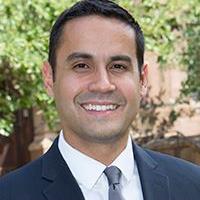Commentary on Matthew 17:1-9
Three weeks on the Sermon on the Mount led us to yet another mountain, this time the Mount of Transfiguration.
As I noted a few weeks back, the mountain is not just a vivid location for this scene but also one imbued with theological significance. Like Moses at Mt. Sinai, Matthew’s Jesus will hear God’s voice directing the prophet and the people alike. Jesus and his disciples will bear witness to the prophetic embodiment of Israelite tradition in Moses and Elijah and hear the voice of God affirming Jesus’ vocation. This dazzling scene is a powerful high point of the Gospel narrative but also one that Christians today may need some help comprehending.
After all, such moments of luminous encounter with God are not all that common. Moreover, the significance of the appearance of Moses and Elijah require some theological explanation. In the end, what does the transfiguration have to do with a walk of faith today? Your preaching can help us make these connections, especially to an emotional, experiential aspects of our faith.
Our text begins with a chronological marker indicating that the transfiguration follows by six days Peter’s dramatic confession and immediate misapprehension of the character of Jesus’ identity and ministry. Peter inherits “the keys of the kingdom of heaven” (Matthew 16:19) but also gets called “Satan” when he seeks to turn Jesus away from the path leading to the cross (verse 23). Matthew 16 then closes with a promise; judgement is coming surely and, importantly, quickly (verses 27-28).
Thus, the transfiguration scene must be read in light of Peter’s insight and failure but also Jesus’ unflinching promise. In short, glory and the cross mix. Suffering and promises of judgment are intertwined. The cross and the glory of God are not at odds.
Six days hence, these promised, transformative realities are confirmed in dramatic fashion. Jesus and three disciples climb “a high mountain,” and there in these heights Jesus is “transfigured before them.” He is numinous and brilliant. His face shines as do his clothes. Jesus radiates light.
That would be enough to stun the disciples and perhaps even Jesus, but then Moses and Elijah also stroll into the scene and start a friendly chat with Jesus. We do not learn immediately how Jesus responds to these events.
Yet Peter’s reaction is recorded even as its precise significance might elude us. Peter offers to “make three dwellings here.” I have heard sermons critiquing Peter for wanting to contain this moment, keep it under a dwelling place to protect it from encroachments. Perhaps his misapprehension of Jesus’ mission in Matthew 16 is still driving his reaction.
But there are other possibilities too. Perhaps Peter is reacting with awe and a deeper understanding of the scene than we tend to assume. What if the offer of dwellings is an act of hospitality for these three servants of God? What if Peter’s reaction is not to be critiqued but understood?
After all, because of the unusual departures of both Moses and Elijah in the Hebrew Scriptures, both played an outsized role in eschatological expectations among many Jews in the first century. While we learn of Moses’ death in the closing verses of Deuteronomy, we also learn that “no one knows his burial place to this day” (Deuteronomy 34:6).
But first, God shows Moses “the whole land” (Deuteronomy 34:1), the promise made to Israel but a land upon which Moses will not tread. Moses, Deuteronomy 34:5 reports, “died there in the land of Moab, at the Lord’s command.” Even in death, Moses is obedient to God’s call. We also learn that even at the age of 120, Moses’ body was not approaching decline; Moses dies because the Lord says it is time.
Later tradition will even note that Moses is buried by God’s own hands, thus explaining why no one knows where he is buried, for no human was there to bear witness to God’s final gift to this mighty servant.1 The very last verses of Deuteronomy laud Moses as an unparalleled prophet, a liberator of his own people though the Lord. Thus, when Moses appears on the mount of transfiguration, he embodies the heights and possibilities of the Israelite prophetic tradition. For Matthew, Moses’ presence affirms the many ways the Gospel of Matthew has sought to align Jesus and Moses.
Elijah’s death is similarly evocative to the theological imagination of first century Judaism. After sharing the spirit of prophecy with Elisha, “… a chariot of fire and horses of fires separated the two of them, and Elijah ascend in a whirlwind into heaven. Elisha kept watching and crying out, ‘Father, father! The chariots of Israel and its horsemen!’ But when he could no longer see him, he grasped his own clothes and tore them in two pieces” (2 Kings 2:11-12; see also Sirach 48:12 and 1 Maccabees 2:58). This dramatic, powerful scene feeds a prophetic hope of Elijah’s return since he did not die in a typical way. Elijah’s return is promised in Malachi 4:5, an expectation Matthew himself alludes to in Matthew 11:14 and Matthew 16:14.
And so, the Transfiguration emerges from a stream of tradition expecting the return of the great prophets Moses and Elijah as harbingers of a divine revolution. Their presence marks Jesus as their heir, their collaborator in this holy work.
And if the presence of Moses and Elijah is insufficient proof of Jesus’ call, then God’s voice settles the matter entirely in verse 5. The voice moves the disciples to fear. Peter, at least, moves from a gesture of hospitality to a holy fear in the presence of the very voice of God.
But Jesus touches them (a detail not to be missed as we see here an embodiment of Jesus’ compassionate, healing, and courage-inducing touch) and asks them not to fear, showing them a scene now more ordinary than numinous. The world has gone back to what it was. No prophets of old. No audible divine voice. No light emanating from Jesus’ face. The world has gone back to what it was. But the disciples cannot return to the same world as they descend from this mount. They have been changed.
But how? How can we help describe this scene of a transformative encounter with the divine? Perhaps we join Elisha exclaiming phrases of awe that don’t quite form sentences. Perhaps we join Peter wanting to host these prophets of old, prophets who have loved a people and yet lost so much. Perhaps we stand in simple silence wondering what this all means.
In the end, it may be best to draw our churches not to a moment of full comprehension of all the theological allusions to be found in this text but to an experience, a feeling. What would it be like to encounter the fullness of God’s promises, not just in words but in the very presence of God’s prophets and God’s unmistakable voice?
Notes
- See James L. Kugel, Traditions of the Bible: A Guide to the Bible As It Was at the Start of the Common Era (Cambridge: Harvard University Press, 1998), 860-1.


February 23, 2020